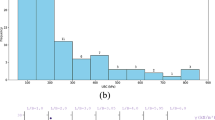Abstract
This paper is devoted to the probabilistic stability analysis of a tunnel face excavated in a two-layer soil. The interface of the soil layers is assumed to be positioned above the tunnel roof. In the framework of limit analysis, a rotational failure mechanism is adopted to describe the face failure considering different shear strength parameters in the two layers. The surrogate Kriging model is introduced to replace the actual performance function to perform a Monte Carlo simulation. An active learning function is used to train the Kriging model which can ensure an efficient tunnel face failure probability prediction without loss of accuracy. The deterministic stability analysis is given to validate the proposed tunnel face failure model. Subsequently, the number of initial sampling points, the correlation coefficient, the distribution type and the coefficient of variability of random variables are discussed to show their influences on the failure probability. The proposed approach is an advisable alternative for the tunnel face stability assessment and can provide guidance for tunnel design.
摘要
本文旨在研究双层土壤中隧道开挖时掌子面的稳定性问题。首先, 假设双层土壤的分界面位于 隧道拱顶上方, 以极限分析方法为依据, 采用旋转破坏机制构建掌子面失稳模型, 同时, 考虑了开挖 介质的剪切强度参数随机性对掌子面稳定性的影响。采用克里金模型代替其原始的功能函数, 进而采 用蒙特卡洛法计算掌子面的破坏概率, 从而大大提高了计算效率和节约了计算成本。本文采用主动学 习函数对克里金模型进行训练, 因此, 可以确保其对掌子面破坏概率的预测高效而不失准确性。本文 首先建立了隧道掌子面破坏模型, 通过计算分析, 验证了所提出模型的正确性, 随后讨论了随机变量 的初始采样点数、相关系数、分布类型和变异系数等对隧道掌子面稳定性的影响。研究结果表明该方 法是一种高效精确的可靠度分析方法, 可以为隧道设计提供一定的理论指导和依据。
Similar content being viewed by others
References
ZHANG Dao-bing, LIU Zhi-zhen, ZHANG Jia-hua. A new failure mechanism for deep cavity and upper bound solution of supporting pressure [J]. Journal of Central South University, 2017, 24(9): 2082–2091.
ASGHAR R, LOHRASB F, MOHAMMAD D. Squeezing rock conditions at phyllite-slate zone in Golab water conveyance tunnel, Iran: A case study [J]. Journal of Central South University, 2017, 24(10): 2475–2485.
LECA E, DORMIEUX L. Upper and lower bound solutions for the face stability of shallow circular tunnels in frictional material [J]. Geotechnique, 1990, 40(4): 581–606.
MICHALOWSKI R L, DRESCHER A. Three-dimensional stability of slopes and excavations [J]. Géotechnique, 2009, 59(10): 839–850.
MOLLON G, DIAS D, SOUBRA A H. Rotational failure mechanisms for the face stability analysis of tunnels driven by a pressurized shield [J]. International Journal for Numerical and Analytical Methods in Geomechanics, 2011, 35(12): 1363–1388.
PAN Q, DIAS D. Upper-bound analysis on the face stability of a non-circular tunnel [J]. Tunnelling and Underground Space Technology, 2017, 62: 96–102.
LI T Z, YANG X L. Probabilistic stability analysis of subway tunnels combining multiple failure mechanisms and response surface method [J]. International Journal of Geomechanics, 2018, 18(12): 04018167.
YANG X, ZHANG S. Risk assessment model of tunnel water inrush based on improved attribute mathematical theory [J]. Journal of Central South University, 2018, 25(2): 379–391.
QIN C B, CHIAN S C. Kinematic analysis of seismic slope stability with a discretisation technique and pseudo-dynamic approach: A new perspective [J]. Geotechnique, 2018, 68(6): 492–503.
ECHARD B, GAYTON N, LEMAIRE M. AK-MCS: An active learning reliability method combining Kriging and Monte Carlo simulation [J]. Structural Safety, 2011, 33(2): 145–154.
SHIHABUDHEEN K V, PILLAI G N, PEETHAMBARAN B. Prediction of landslide displacement with controlling factors using extreme learning adaptive neuro-fuzzy inference system (ELANFIS) [J]. Applied Soft Computing, 2017, 61: 892–904.
PAN Q, DIAS D. An efficient reliability method combining adaptive support vector machine and Monte Carlo simulation [J]. Structural Safety, 2017, 67: 85–95.
LI Y X, YANG X L. Soil-slope stability considering effect of soil-strength nonlinearity [J]. International Journal of Geomechanics, 2019, 19(3): 04018201.
LI Z W, YANG X L. Kinematical analysis of active earth pressure considering tension crack, pore-water pressure and soil nonlinearity [J]. KSCE Journal of Civil Engineering, 2019, 23(1): 56–62.
XU J S, YANG X L. Seismic stability of 3D soil slope reinforced by geosynthetic with nonlinear failure criterion [J]. Soil Dynamics and Earthquake Engineering, 2019, 118: 86–97.
ZHANG J H, WANG W J, ZHANG D B, ZHANG B, MENG F. Safe range of retaining pressure for three-dimensional face of pressurized tunnels based on limit analysis and reliability method [J]. KSCE Journal of Civil Engineering, 2018, 22(11): 4645–4656.
HUANG F, ZHAO L H, LING T H, YANG X L. Rock mass collapse mechanism of concealed karst cave beneath deep tunnel [J]. International Journal of Rock Mechanics and Mining Sciences, 2017, 91: 133–138.
ZHANG J, HUANG H W, PHOON K K. Application of the Kriging-based response surface method to the system reliability of soil slopes [J]. Journal of Geotechnical and Geoenvironmental Engineering, 2012, 139(4): 651–655.
QIN C B, CHIAN S C. Bearing capacity analysis of a saturated non-uniform soil slope with discretization-based kinematic analysis [J]. Computers and Geotechnics, 2018, 96: 246–257.
LI Z W, YANG X L. Active earth pressure for soils with tension cracks under steady unsaturated flow conditions [J]. Canadian Geotechnical Journal, 2018, 55(12): 1850–1859.
CHERUBINI C. Reliability evaluation of shallow foundation bearing capacity on c’φ’ soils [J]. Canadian Geotechnical Journal, 2000, 37(1): 264–269.
WOLFF T F. Analysis and design of embankment dam slopes: A probabilistic approach [D]. West Lafayette: Purdue University, 1985.
LI Y X, YANG X L. Three-dimensional seismic displacement analysis of rock slopes based on Hoek-Brown failure criterion [J]. KSCE Journal of Civil Engineering, 2018, 22(11): 4334–4344.
XU J S, LI Y X, YANG X L. Seismic and static 3D stability of two-stage slope considering joined influences of nonlinearity and dilatancy [J]. KSCE Journal of Civil Engineering, 2018, 22(10): 3827–3836.
Author information
Authors and Affiliations
Corresponding author
Additional information
Foundation item
Projects supported by the China Scholarship Council
Rights and permissions
About this article
Cite this article
Li, Tz., Dias, D. Tunnel face reliability analysis using active learning Kriging model—Case of a two-layer soils. J. Cent. South Univ. 26, 1735–1746 (2019). https://doi.org/10.1007/s11771-019-4129-0
Received:
Accepted:
Published:
Issue Date:
DOI: https://doi.org/10.1007/s11771-019-4129-0




